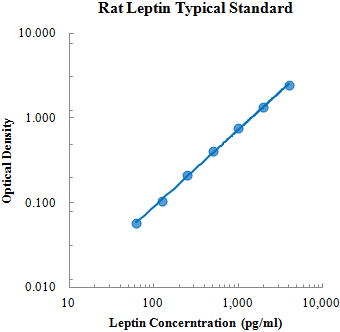Rat Leptin ELISA Kit
$299.00 – $419.00
ELISA Kit Detail Information
| Related Target | |
|---|---|
| Species | rat |
| Sample Type | Serum, plasma, cell culture supernatant, and other biological samples |
| Sample Volume | 100 μL (diluent) |
| Sensitivity | 1.14 pg/mL |
| Array Range | 62.5 pg/mL – 4000 pg/mL |
| Assay Time | 3.5 h |
| Recovery | 92% – 130% |
| Average Recovery | 107% |
| Intra Precision | 3.5% – 4.6% |
| Inter Precision | 4.2% – 4.7% |
| Plate | Detachable 96-well plate |
| Storage | If the reagent kit is unopened, it should be stored at 4℃. However, if it has been opened, the standard solution should be stored at -20℃, while the other components should be stored at 4℃. |
| Delivery | 4℃ blue ice transportation |
| Components | 96-well polystyrene enzyme-linked immunosorbent assay (ELISA) plate coated with anti- Leptin monoclonal antibody Rat Leptin freeze-dried standard Leptin detect Antibody Assay Buffer(10×) Substrate TMB Stop Solution Washing Buffer(20×) Sealing Film |
| Assay Principle | This kit utilizes the double antibody sandwich enzyme-linked immunosorbent assay (ELISA) detection technique.Specific anti-rat Leptin antibodies are precoated on a high-affinity ELISA plate. Standard samples, test samples, and biotinylated detection antibodies are added to the wells of the ELISA plate. After incubation, Leptin present in the samples binds to the solid-phase antibodies and the detection antibodies. After washing to remove unbound substances, streptavidin-HRP labeled with horseradish peroxidase is added. After washing, a colorimetric substrate, TMB, is added and the plate is incubated in the dark for color development. The intensity of the color reaction is directly proportional to the concentration of Leptin in the samples.A stop solution is added to terminate the reaction, and the absorbance value is measured at a wavelength of 450 nm (with a reference wavelength range of 570-630 nm). |
Related Targets
LEP
LEP Target Infomation Overview
- Target Symbol: LEP, leptin
- Gene Groups: Neuropeptides
- Previous Names: OBS; OB
- Alias Names: leptin (murine obesity homolog); leptin (obesity homolog, mouse)
LEP, leptin Target Infomation by Species
- Human
- Mouse
- Rat
Human LEP Target Information
- Target Symbol: LEP, leptin
- Alias:
- FLJ94114
- LEPD
- leptin (murine obesity homolog)
- leptin (obesity homolog, mouse)
- OB
- obese protein
- obese, mouse, homolog of
- obesity factor
- OBS
- NCBI_Gene: 3952
- UniProtKB: P41159
Human LEP Predicted Functions
Enables leptin receptor binding activity. Involved in several processes, including positive regulation of signal transduction; regulation of cytokine production; and regulation of lymphocyte proliferation. Predicted to be located in cytosol. Predicted to be active in extracellular space. Implicated in several diseases, including alcohol dependence; congenital leptin deficiency; liver disease (multiple); lung disease (multiple); and type 2 diabetes mellitus. Biomarker of several diseases, including alcohol dependence; cystic fibrosis; fatty liver disease (multiple); liver disease (multiple); and lung disease (multiple).
Mouse Lep Target Information
- Target Symbol: Lep, leptin
- Alias:
- ob
- obese
- NCBI_Gene: 16846
Mouse Lep Predicted Functions
Enables DNA binding activity and growth factor activity. Involved in several processes, including cell surface receptor signaling pathway; positive regulation of cytokine production; and positive regulation of signal transduction. Acts upstream of or within several processes, including insulin secretion; monocarboxylic acid metabolic process; and regulation of insulin secretion. Located in cytoplasm and extracellular space. Is expressed in several structures, including adipose tissue; alimentary system; central nervous system; early conceptus; and genitourinary system. Used to study abdominal obesity-metabolic syndrome (multiple); fatty liver disease (multiple); obesity; and type 2 diabetes mellitus. Human ortholog(s) of this gene implicated in several diseases, including alcohol dependence; congenital leptin deficiency; liver disease (multiple); lung disease (multiple); and type 2 diabetes mellitus. Orthologous to human LEP (leptin).
Rat Lep Target Information
- Target Symbol: Lep, leptin
- Alias:
- OB
- obese
- obesity (murine homolog leptin)
- obesity factor
- NCBI_Gene: 25608
Rat Lep Predicted Functions
Enables hormone activity and peptide hormone receptor binding activity. Involved in several processes, including positive regulation of cell communication; regulation of apoptotic process; and response to vitamin. Located in cytosol and extracellular space. Used to study several diseases, including alcohol dependence; glucose metabolism disease (multiple); liver disease (multiple); neurodegenerative disease (multiple); and short bowel syndrome. Biomarker of several diseases, including Huntington’s disease; alcohol dependence; fatty liver disease (multiple); lipid metabolism disorder (multiple); and obesity. Human ortholog(s) of this gene implicated in several diseases, including alcohol dependence; congenital leptin deficiency; fatty liver disease (multiple); liver disease (multiple); and lung disease (multiple). Orthologous to human LEP (leptin).














Reviews
There are no reviews yet.